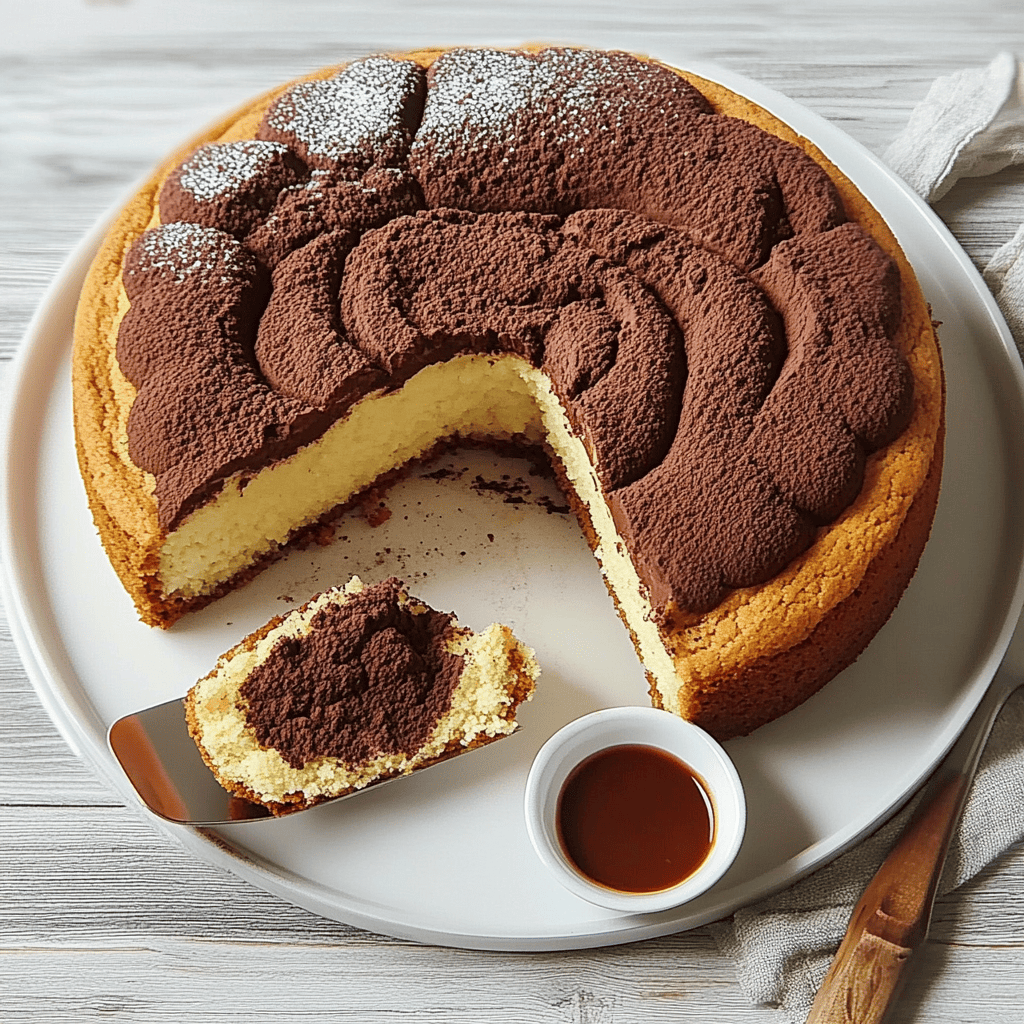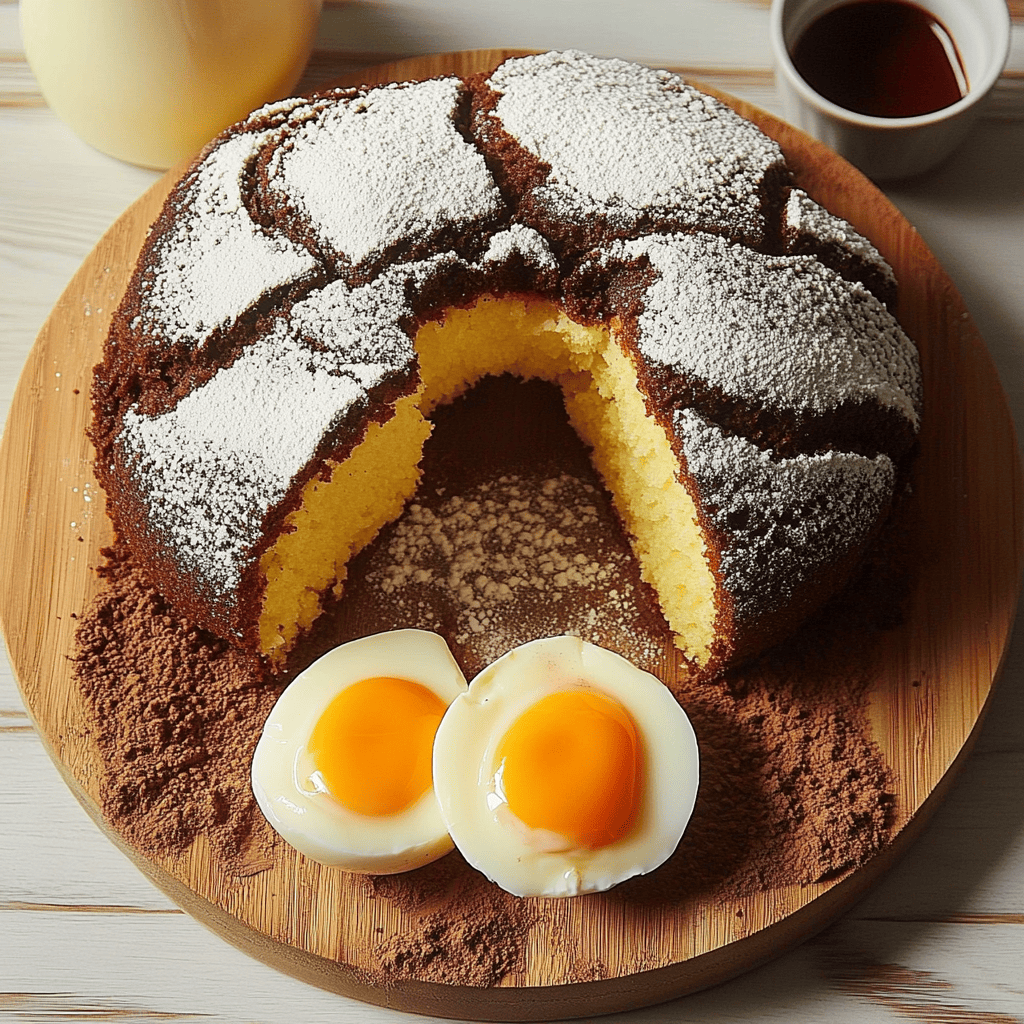Marbled Cake
Introduction
Marble cake is a classic dessert that combines two iconic flavors: vanilla and chocolate. Its distinctive swirling or veined design makes it a visually appealing dessert, ideal for special occasions or simply to enjoy with the family. This cake is known for its fluffy texture and perfect balance of sweetness and flavor. Its preparation is simple, but requires attention to detail to achieve its distinctive marbled effect.
Marble cake is a classic pastry delight that combines two universally beloved flavors: vanilla and chocolate. Its name comes from the distinctive design formed when the two batters are mixed together, creating a veined or swirling effect reminiscent of marble. This dessert stands out not only for its balanced flavor and fluffy texture, but also for its visual appeal, making it a perfect choice for celebrations, family gatherings, or simply for a moment of indulgence.
Preparing a marble cake is relatively simple, but it requires some attention to detail to achieve the perfect marbled effect. The key is alternating the two batters (vanilla and chocolate) and using a gentle technique to mix them, without completely blending them. This allows the beautiful veins that make it so special to be revealed when cut into the cake.
In addition to its taste and appearance, marble cake is a versatile dessert. It can be served alone, accompanied by a cup of coffee or tea, or even decorated with icing, fruit, or whipped cream for more special occasions. Its popularity has crossed borders, becoming a classic in many cultures, each adapting it to their own tastes and traditions.
In short, marble cake is much more than a simple dessert; it’s a sensorial experience that combines flavor, texture, and visual beauty. Making it is an opportunity to explore creativity in the kitchen and share a sweet moment with those you love most. Get ready to enjoy this timeless classic!
Detailed History
The origin of marble cake dates back to Europe, where cakes and pastries have been part of traditional baking for centuries. The technique of combining two doughs of different colors or flavors to create a visual effect became popular in the 19th century, when cocoa powder became more accessible and was incorporated into home baking.
The term “marbled” comes from the similarity of the dough’s veins to the appearance of marble, a natural rock with veins of different shades. This technique is not only used in cakes, but also in other desserts such as cheesecakes, brownies, and cookies. Over time, marbled cake has become a classic in many countries, adapting to local tastes and preferences.
Marble cake, with its distinctive veining and combination of flavors, has a fascinating history dating back several centuries. Its origins are closely tied to the development of baking in Europe, where cakes and pastries have been a fundamental part of culinary culture since the Middle Ages.
Origins in Europe
The concept of mixing batters of different colors or flavors to create a visual effect became popular in the 19th century, although its roots can be traced back even earlier. During the Renaissance, European pastry chefs began experimenting with more elaborate techniques to create desserts that were not only delicious but also visually stunning. Marbling, inspired by the natural veining of marble, became a technique prized for its beauty and elegance.
With the arrival of cocoa powder in Europe in the 16th century, following the discovery of America, bakers began incorporating chocolate into their recipes. However, it wasn’t until the 19th century, with industrialization and the widespread availability of ingredients like cocoa and baking powder, that marble cake became established as a popular dessert in homes and bakeries.
Expansion and Adaptation
As the pastry industry spread throughout the world, marble cake was adapted to local tastes and traditions. In some countries, ingredients such as spices, dried fruits, or liqueurs were added to give it a unique touch. For example, in Germany, it is known as “Marmorkuchen” and is a traditional dessert in many families. In the United States, marble cake became popular in the 20th century as a classic home baking, especially for celebrations such as birthdays and family gatherings.
Marble Cake Today
Today, marble cake remains a beloved and versatile dessert. Its preparation has been simplified thanks to the availability of pre-mixed ingredients and modern tools, but many people still prefer the traditional, made-from-scratch recipe. Furthermore, with the rise of creative baking, marble cake has inspired new variations, such as versions with matcha, fruit, or even more elaborate designs.
A Dessert with History and Tradition
Marble cake isn’t just a dessert; it’s a reflection of the evolution of pastry making over the centuries. Its combination of simplicity and elegance has made it a timeless classic, capable of adapting to modern trends without losing its essence. Whether in a fine pastry shop or on a home table, this cake remains a symbol of creativity and culinary enjoyment.
In short, the history of marble cake is a journey through time, showing us how a dessert can transcend borders and generations, always remaining relevant and appreciated. A true gem of global baking!

INGREDIENTS TO PREPARE THE RECIPE.
200 g sugar
4 large eggs
200 g wheat flour
200 g butter at room temperature
1 sachet of baking powder
1 pinch of salt
2 tablespoons unsweetened cocoa powder
1 teaspoon vanilla extract
60 ml milk
PREPARATION INSTRUCTIONS.
– Preheat the oven to 180°C. Grease and flour a cake tin or place baking paper on the bottom.
– Prepare the base mix: In a large bowl, beat the butter and sugar until smooth and fluffy. Add the eggs one by one, beating well after each addition.
– Stir in the dry ingredients: Sift the flour, baking powder, and salt. Add them to the butter and egg mixture little by little, alternating with the milk and vanilla extract. Mix gently with folding movements to avoid losing air. –
Divide the dough: Separate the mixture into two equal parts. In one part, add the sifted cocoa powder and mix well until you get a smooth chocolate batter.
– Create the marbled effect: Alternately pour spoonfuls of the vanilla batter and chocolate batter into the prepared pan. Using a knife or skewer, gently swirl the batter to create the marbled effect, being careful not to overmix.
– Place the pan in the preheated oven and bake for 35-45 minutes, or until a toothpick inserted in the center comes out clean.
– Once baked, let the cake cool in the pan for 10 minutes and then turn it out onto a wire rack to cool completely.

Questions :
- Can I substitute butter for another ingredient?
Yes, you can use margarine or vegetable oil, although the final texture may vary slightly. - What type of pan is best?
A round or rectangular pan, approximately 20-22 cm in diameter, is ideal. Make sure to grease and flour it well to prevent the cake from sticking. - How do I know if the cake is done?
Insert a toothpick into the center of the cake. If it comes out clean, it’s done. If there’s any batter left, let it bake for a few more minutes. - Can I add other flavors?
Sure! You can experiment with essences like almond, orange, or even coffee to give it a personalized touch. - How to store marble cake?
Store it in an airtight container at room temperature for 2-3 days. You can also refrigerate it for a longer shelf life. - Can it be frozen?
Yes, you can freeze it wrapped in plastic or foil for up to a month. Thaw at room temperature before serving.
Estimated preparation time:
- Preparation: 20 minutes
- Baking: 40–45 minutes at 180 °C
- Cooling: 15 minutes
- Total approx.: 1 hour 15 minutes
Texture and flavor:
- Texture: Soft, spongy, and moist. The cocoa gives it a denser texture that contrasts delightfully with the vanilla.
- Flavor: Balanced between sweetness and the bitterness of cocoa. Vanilla provides a comforting fragrance.
Consumption context:
- Ideal as a dessert or snack.
- Perfect with a cup of coffee, tea or milk.
- Suitable for celebrations, family breakfasts, or simply a sweet treat.
Visual appearance:
- Spiral or marbled cut with dark brown (cocoa) and light beige (vanilla) veins.
- Golden exterior with a thin, slightly crispy crust.
Curiosities:
- Marble cake is a classic of European pastry and became popular in America in the 19th century.
- It is traditionally baked in “bundt” or elongated molds.
Estimated nutritional value (80g serving, approx. 10 servings):
- Calories: ~310 kcal
- Fat: 18 g (of which 11 g are saturated)
- Carbohydrates: 32 g
- Sugars: 18 g
- Protein: 5 g
Additional benefits and interesting facts:
- It can be adapted to be gluten-free (using rice flour or gluten-free mix).
- Stores well in refrigerator for up to 5 days or in freezer for 2 months.
- You can add orange zest, nuts, or chocolate chips to give it more personality.
- A homemade cake will always be healthier than industrial versions due to the controlled ingredients.

Conclusion
Marble cake is a versatile and delicious recipe that combines the best of both worlds: the smoothness of vanilla and the intensity of chocolate. Its preparation is accessible even for baking beginners, and its presentation makes it perfect for any occasion. Furthermore, its history and evolution reflect how baking has adapted to the tastes and resources available in each era.
This dessert not only satisfies the palate, but also provides an opportunity to explore your creativity in the kitchen. Whether for a special breakfast, a snack, or dessert, marble cake is a timeless option. Go ahead and make it and surprise your loved ones with this baking classic!
Chocolate cake, an irresistible classic in global confectionery, is not only a delicious dessert but also a symbol of celebration and enjoyment. With its rich texture, deep flavor, and versatile combination of ingredients, chocolate cake adapts to a wide variety of tastes, from the simplest to the most sophisticated. The key to a good chocolate cake lies in the quality of the cocoa used, the balance of ingredients, and the preparation technique.
Furthermore, this cake has transcended being just a sweet treat; it has become a tradition at birthdays, weddings, and other festivities, giving it an important place in culinary culture. While there are many variations, such as chocolate ganache cake, mousse cake, or tres leches cake, they all share the same essence: a love of cocoa and the satisfaction of the senses.
In conclusion, chocolate cake is not just a dessert, but a sensory experience that has endured over the years thanks to its versatility, its unmistakable flavor, and its ability to create memorable moments. Whether served as a small daily treat or as a centerpiece at special events, chocolate cake remains a symbol of culinary pleasure and a favorite across generations.

